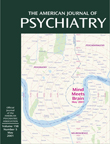The Dexamethasone Suppression Test and Suicide Prediction
Abstract
OBJECTIVE: Despite the substantial risks of eventual suicide associated with major depressive disorder, clinicians lack robust predictors with which to quantify these risks. This study compared the validity of demographic and historical risk factors with that of the dexamethasone suppression test (DST), a clinically practical measure of hyperactivity of the hypothalamic-pituitary-adrenal (HPA) axis. METHOD: Seventy-eight inpatients with Research Diagnostic Criteria major depressive disorder or schizoaffective disorder, depressed type, entered a long-term follow-up study between 1978 and 1981, and, in addition, underwent a 1-mg DST. The number of suicides in this group during a 15-year follow-up period was determined, and the predictive validity of four demographic and historical risk factors reported in the literature to be consistently predictive of suicide in depressed patients was compared to the predictive validity of the DST results. RESULTS: Thirty-two of the 78 patients had abnormal DST results. Survival analyses showed that the estimated risk for eventual suicide in this group was 26.8%, compared to only 2.9% among patients who had normal DST results. None of the demographic and historical risk factors examined in the study significantly distinguished those who later committed suicide from those who did not. CONCLUSIONS: In efforts to predict and prevent suicidal behavior in patients with major depressive disorder, HPA-axis hyperactivity, as reflected in DST results, may provide a tool that is considerably more powerful than the clinical predictors currently in use. Research on the pathophysiology of suicidal behavior in major depressive disorder should emphasize the HPA axis and its interplay with the serotonin system.



